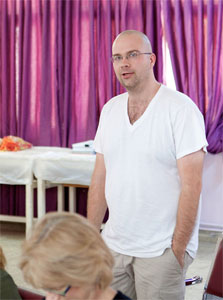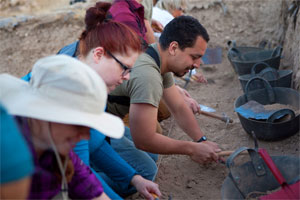Weekly Reports from Jordan
Choose Year: or Choose week
Week 1 – Setting out on this Adventure
Douglas R. Clark, Director
MPP-`Umayri 2016
Archaeological Adventure
Photographer: Jillian Logee
 |
 |
Orientation
 The 2016 season of excavations at Tall al-`Umayri, Jordan (the 18th season at the site) officially began with Orientation on Wednesday morning, 22 June 2016 at the Amman Training Centre (ATC) in Jordan. Most of the 32 participants scheduled for this season met in the Commons Room and were alert and awake having arrived from the United States, Canada, and Australia the previous day. Jet lag awakens travelers around 2 am and contributes to serious fading by around 2 pm. But everyone survived even a mid-afternoon romp through the ever-scintillating Excavation Manual with its page-turning suspense and high drama.
The 2016 season of excavations at Tall al-`Umayri, Jordan (the 18th season at the site) officially began with Orientation on Wednesday morning, 22 June 2016 at the Amman Training Centre (ATC) in Jordan. Most of the 32 participants scheduled for this season met in the Commons Room and were alert and awake having arrived from the United States, Canada, and Australia the previous day. Jet lag awakens travelers around 2 am and contributes to serious fading by around 2 pm. But everyone survived even a mid-afternoon romp through the ever-scintillating Excavation Manual with its page-turning suspense and high drama.
One nice feature of opening day involves self-introductions by team members during which they share reasons they have come a half-world away from home to dig in foreign soil under the hot sun, while their own gardens are languishing in their absence. Hailing from several mostly western universities (La Sierra University in Riverside, CA; Burman University in Alberta, Canada; Mount Royal University in Alberta, Canada; Walla Walla University in Washington State; and Pacific Union College outside San Francisco), students come for an archaeology adventure of a lifetime. Others are archaeology lifers who long ago decided that their future lay in ruins and continue with the project to this day, addicted to the very end.
 |
 |
Orientation occupied the first half-week, which included a day and a half of meetings in the Commons Room of Dormitory A to familiarize team members with each other, with the Department of Antiquities of Jordan, with administrators of ATC, with how to survive in one of the most water-pour countries in the world (especially taking showers using a gallon or so of water and depositing absolutely no paper products in Turkish or western toilets which are part of a septic system not designed to consume much water, both practices which take some getting used to and some time to change once participants return home), with school rules about wake-up time (4:15 am to the sound of two piercing bells of varying pitch, rung asynchronously), with tools for navigating the myriad cultural differences between home and here with grace and elan, with all the logistical information one will need for the summer … and more.
 |
 |
DEVOTIONAL
It all began with a brief devotional drawn from sacred texts about nobility, charity, community, compassion, and friendship: the Old Testament (Psalm 133), the Dead Sea Scrolls (The Rule of the Community 2:24-25), the New Testament (Philippians 4:8), and the Qur‘an (Surah 49:13), brought to a conclusion with a reportedly extemporaneous Bedouin Sheik’s prayer from several decades ago near Hebron. The prayer includes his request for ten things characterized by generosity and integrity:
O God, shaper of the trees and fruit,
Maker of the sun,
Grant me the ten things I ask for.
No man can wish for more while he lives.
Stand, O Lord, and write them into my destiny.
First, I pray for a large and shade-giving tent,
A tent that is open all the day long,
To which the people are happy to come.
Next I pray for a woman to be my wife,
Beautiful of face and remarkable in her ways,
A wife who is quick to set her hands to cooking
As soon as she sees a guest.
Third, O God, preserve my honor from shame.
Let no man blacken my name.
Fourth, I wish for a red mare who runs fast under the hot sun,
And in my hand a gun that never misses the mark.
Fifth, give me goats and sheep in flocks so large
That the work of the shepherd is hard:
Much meat for my guests to eat their fill.
Sixth, I wish for camels with udders full of milk—
Drink to offer any man who passes this way.
Seventh, I pray for men brave and true,
A loyal band to ride by my side
And keep safe the lands of my quarter.
Eighth, give me leave to make the pilgrimage to Mecca
To visit my friend Mohammad.
Ninth, after a life that is long,
Help me, O god, to answer the Angels of Death,
Both Naker and Nkeer,
When they question me in my grave.
And tenth, save me from the fire of hell;
Let paradise be my lot.
[Arab Folktales, by Inea Bushnaq – 1987]
SITE VISITS and STUDY TOURS

 Cultural immersion is one of the time-honored goals of the `Umayri excavations for its students and volunteers, and one way to realize that objective is through tours and site visits. During Orientation we travel by bus to all three Madaba Plains Project sites -- `Umayri, Hisban, and Jalul – attempting to capture something of the regional nature of our work (people did not live only or even for the most part in cities, after all).
Cultural immersion is one of the time-honored goals of the `Umayri excavations for its students and volunteers, and one way to realize that objective is through tours and site visits. During Orientation we travel by bus to all three Madaba Plains Project sites -- `Umayri, Hisban, and Jalul – attempting to capture something of the regional nature of our work (people did not live only or even for the most part in cities, after all).
 |
 |
 |
 |
 |
 |
 |
 The first Sunday of each season we travel around Amman, this time visiting the second-century, 5,000-seat Roman Theater in the center of Old Amman, along with the attached Odeon, used for smaller, often musical performances 2,000 years ago and today. Then to the newly opened Jordan Museum with its fabulous displays depicting human life and survival from pre-historic times through the modern period (the second floor is not yet open but will display Islamic history in Jordan). The predecessor museum atop “The Citadel” (where King David sent Uriah the Hittite to his untimely death) is a small, aging, and very tired museum, but some of its holdings are world treasures.
The first Sunday of each season we travel around Amman, this time visiting the second-century, 5,000-seat Roman Theater in the center of Old Amman, along with the attached Odeon, used for smaller, often musical performances 2,000 years ago and today. Then to the newly opened Jordan Museum with its fabulous displays depicting human life and survival from pre-historic times through the modern period (the second floor is not yet open but will display Islamic history in Jordan). The predecessor museum atop “The Citadel” (where King David sent Uriah the Hittite to his untimely death) is a small, aging, and very tired museum, but some of its holdings are world treasures.
 |
 |
Sites along the Kings Highway to the south of Amman occupied our attention after the first full week of excavation. Places like Mount Nebo (memorable in the Moses story), Madaba (important throughout biblical history and known especially for its multitude of Christian churches mostly from the 6th century AD), Mukawir (Machaerus of the story of the beheading of John the Baptist), Ataruz (Israelite/Moabite site famous for religious remains, being excavated by Chang Ho Ji of La Sierra), Dhiban (site of the discovery of the famous Moabite Stone or Mesha Stela), Lahun (Iron Age site overlooking the Wadi Mujib, Jordan’s Grand Canyon), and Umm Ar-Rasas (home of the best Byzantine church mosaic in the country, Saint Stephens Church, boasting representations of churches all over the region and built over a century into the Islamic Period).
 |
 |
IFTAR
Holding an excavation during Ramadan in a predominantly Muslim country carries challenges for an outdoor work-intensive schedule. It also holds promise for extending and expanding relationships with friends in this part of our global community. One of these opportunities comes in the form of invitations to celebrate Iftar meals, the breaking of the fast immediately following sunset, most often observed in a family setting. Some of our team have enjoyed a couple of these important events, one in which ten of us went to the villa of Dr. Mustafa Al-Barari, a one-time president of the Audit Bureau of Jordan and now an influential businessman who earned an MBA from La Sierra University as well as an Honorary Doctorate. His wife and family of four daughters and two sons perfectly embodied typical Arab hospitality, laying out a splendid meal.
 |
 |
OVERHEARD
“This is not Islam”
Mohammad Ahmaro, Steward of ATC, at an iftar dinner with his family to which I was invited at his home during Ramadan. Mohammad was explaining the Qur‘an and what it says about peace, brotherhood, and love as opposed to the actions of extremists in the region who claim Islam as their faith, but who really do not belong.
VISITING VP
A special guest during the first week of the excavation, Marilyn Thomsen, Vice President for Marketing and Communication at La Sierra University, came to document the many roles of La Sierra University in Jordan. While other administrators from La Sierra have graced our excavations in the past, Marilyn broke with tradition and decided she would stay with the team at our home away from home, the Amman Training Centre, an UNRWA vocational school for Palestinians. While the school offers us a large dining hall, two dormitory buildings, covered spaces along Cypress-lined walkways, its estimated 0.3-star accommodations made her feel a bit more a part of the team and gave her opportunities 24/7 to connect with team members and hear their stories.
The quest for human-interest stories about La Sierra connections took Marilyn to an evening iftar meal at Mustafa Al-Barari’s home; a visit (along with Kent Bramlett and me) with the Director General of the Department of Antiquities of Jordan (DoA); a shopping trip in the downtown Amman souk with one of our DoA representatives, Samia Khouri, to purchase what must be the best embroidered Bedouin dress available anywhere; a tour with Kent Bramlett and Friedbert Ninow of archaeological sites outside La Sierra’s main project (Tall al-`Umayri) to Ataruz (directed by La Sierra’s Chang Ho Ji), and Khirbat Balu’a, directed by Friedbert Ninow; and scores of conversations, tape recorded notes, and the beginnings of lots of stories to tell.
OFF TO A GREAT START
So, we are off to a great start to our excavation season at `Umayri (22 June-27 July). Extremely hot weather for over a week has kindly given way to more normal summer temperatures near 90 degrees. With absolutely no chance of rain in the forecast, at least the weather is predictable, even if at times pleasant early morning clouds arise from the west, dissipating as they pass overhead toward the eastern desert.
Let the adventure begin!
